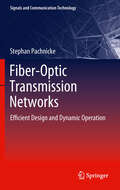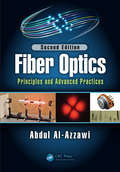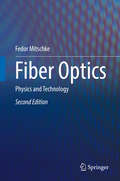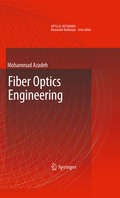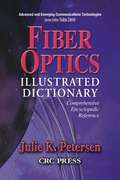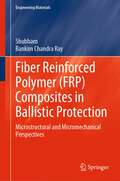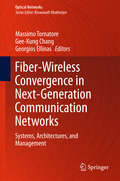- Table View
- List View
Fiber Optic Sensors (Optical Science and Engineering)
by Shizhuo Yin Paul B. Ruffin Francis T. S. YuThe need for both intrinsic and extrinsic fiber optic sensor technologies continues to grow. To meet the demands of this fast expanding applications-driven market, Fiber Optic Sensors, Second Edition presents both the latest advances in fiber optic sensor technology, such as the application of photonic crystal fibers to fiber optic gyroscopes, and recent application opportunities, including the use of fiber optic sensors as a minimally invasive medical treatment. The new edition of this seminal work highlights the development of fiber optic sensors, while providing an overview of current methods for the construction of high-speed and high-capacity fiber optic systems. Two new chapters cover topics such as femtosecond laser illumination inscription and the growing application sector of fiber optic chemical and biological sensors. Adding significant new material, the book continues to provide a progressive history of each sensor type as well as basic principles and fundamental building blocks for practical applications in the electrical aerospace, defense and manufacturing, smart structure, undersea surveillance, medical, and gas and oil industries.
Fiber-Optic Transmission Networks: Efficient Design and Dynamic Operation (Signals and Communication Technology)
by Stephan PachnickeNext generation optical communication systems will have to transport a significantly increased data volume at a reduced cost per transmitted bit. To achieve these ambitious goals optimum design is crucial in combination with dynamic adaptation to actual traffic demands and improved energy efficiency. In the first part of the book the author elaborates on the design of optical transmission systems. Several methods for efficient numerical simulation are presented ranging from meta-model based optimization to parallelization techniques for solving the nonlinear Schrödinger equation. Furthermore, fast analytical and semi-analytical models are described to estimate the various degradation effects occurring on the transmission line.In the second part of the book operational aspects of optical networks are investigated. Physical layer impairment-aware routing and regenerator placement are studied. Finally, it is analyzed how the energy efficiency of a multi-layer optical core network can be increased by dynamic adaptation to traffic patterns changing in the course of the day.
Fiber Optics: Principles and Advanced Practices, Second Edition
by Abdul Al-AzzawiThis book provides a step-by-step discussion through each topic of fiber optics. Each chapter explores theoretical concepts of principles and then applies them by using experimental cases with numerous illustrations. The book works systematically through fiber optic cables, advanced fiber optic cables, light attenuation in optical components, fiber optic cable types and installations, fiber optic connectors, passive fiber optic devices, wavelength division multiplexing, optical amplifiers, optical receivers, opto-mechanical switches, and optical fiber communications. It includes important chapters in fiber optic lighting, fiber optics testing, and laboratory safety.
Fiber Optics: Principles and Advanced Practices, Second Edition
by Abdul Al-AzzawiThis book provides a step-by-step discussion through each topic of fiber optics. Each chapter explores theoretical concepts of principles and then applies them by using experimental cases with numerous illustrations. The book works systematically through fiber optic cables, advanced fiber optic cables, light attenuation in optical components, fiber optic cable types and installations, fiber optic connectors, passive fiber optic devices, wavelength division multiplexing, optical amplifiers, optical receivers, opto-mechanical switches, and optical fiber communications. It includes important chapters in fiber optic lighting, fiber optics testing, and laboratory safety.
Fiber Optics: Physics and Technology
by Fedor MitschkeTelephone, telefax, email and internet - the key ingredient of the inner workings is the conduit: the line which is designed to carry massive amounts of data at breakneck speed. In their data-carrying capacity optical fiber lines beat other technologies (copper cable, microwave beacons, satellite links) hands down, at least in the long haul. This book is a comprehensive source about optical fibers: Their structure, their light-guiding mechanism, their material and manufacture, their use. Several effects tend to degrade the signal as it travels down the fiber: they are spelled out in detail. Nonlinear processes are given due consideration for a twofold reason: On one hand they are fundamentally different from the more familiar processes in electrical cable. On the other hand, they form the basis of particularly interesting and innovative applications, provided they are understood well enough. A case in point is the use of so-called solitons, i.e. special pulses of light which have the wonderful property of being able to heal after perturbation. The book starts with the physical basics of ray and beam optics, explains fiber structure and the functions of optical elements, and continues to the forefront of applications. The state of the art of high speed data transmission will be described, and the use of fiber optic sensors in metrology is treated. The book is written in a pedagogical style so that students of both physics and electrical engineering, as well as technicians and engineers involved in optical technologies, will benefit.
Fiber Optics: Physics and Technology
by Fedor MitschkeThis book tells you all you want to know about optical fibers: Their structure, their light-guiding mechanism, their material and manufacture, their use.It began with telephone, then came telefax and email. Today we use search engines, music downloads and internet videos, all of which require shuffling of bits and bytes by the zillions. The key to all this is the conduit: the line which is designed to carry massive amounts of data at breakneck speed. In their data carrying capacity optical fiber lines beat all other technologies (copper cable, microwave beacons, satellite links) hands down, at least in the long haul; wireless devices rely on fibers, too. Several effects tend to degrade the signal as it travels down the fiber: they are spelled out in detail. Nonlinear processes are given due consideration for a twofold reason: On the one hand they are fundamentally different from the more familiar processes in electrical cable. On the other hand, they form the basis of particularly interesting and innovative applications, provided they are understood well enough. A case in point is the use of so-called solitons, i.e. special pulses of light which have the wonderful property of being able to heal after perturbation. The book will take you from the physical basics of ray and beam optics, explain fiber structure and the functions of optical elements, and bring you to the forefront of both applications and research. The state of the art of high speed data transmission is described, and the use of fiber optic sensors in metrology is treated. The book is written in a pedagogical style so that students of both physics and electrical engineering, as well as technicians and engineers involved in optical technologies, will benefit. The new edition is largely updated and has new sections on nonlinear phenomena in fibers as well as on the latest trends in applications.
Fiber Optics: Technology and Applications (Applications of Communications Theory)
by Stewart D. PersonickThis book is an outgrowth of a course given by the author for people in industry, government, and universities wishing to understand the implica tions of emerging optical fiber technology, and how this technology can be applied to their specific information transport and sensing system needs. The course, in turn, is an outgrowth of 15 exciting years during which the author participated in the research and development, as well as in the application, of fiber technology. The aim of this book is to provide the reader with a working knowledge of the components and subsystems which make up fiber systems and of a wide variety of implemented and proposed applications for fiber technology. The book is directed primarily at those who would be users, as opposed to developers, of the technology. The first half of this book is an overview of components and subsys tems including fibers, connectors, cables, sources, detectors, receivers, transmitters, and miscellaneous components. The goal is to familiarize the reader with the properties of these components and subsystems to the extent necessary to understand their potential applications and limitations.
Fiber Optics Engineering (Optical Networks)
by Mohammad AzadehWithin the past few decades, information technologies have been evolving at a tremendous rate, causing profound changes to our world and our ways of life. In particular, fiber optics has been playing an increasingly crucial role within the telecommunication revolution. Not only most long-distance links are fiber based, but optical fibers are increasingly approaching the individual end users, providing wide bandwidth links to support all kinds of data-intensive applications such as video, voice, and data services. As an engineering discipline, fiber optics is both fascinating and challenging. Fiber optics is an area that incorporates elements from a wide range of techno- gies including optics, microelectronics, quantum electronics, semiconductors, and networking. As a result of rapid changes in almost all of these areas, fiber optics is a fast evolving field. Therefore, the need for up-to-date texts that address this growing field from an interdisciplinary perspective persists. This book presents an overview of fiber optics from a practical, engineering perspective. Therefore, in addition to topics such as lasers, detectors, and optical fibers, several topics related to electronic circuits that generate, detect, and process the optical signals are covered. In other words, this book attempts to present fiber optics not so much in terms of a field of “optics” but more from the perspective of an engineering field within “optoelectronics.
Fiber Optics Illustrated Dictionary (Advanced & Emerging Communications Technologies)
by J.K. PetersenWithin a few short years, fiber optics has skyrocketed from an interesting laboratory experiment to a billion-dollar industry. But with such meteoric growth and recent, exciting advances, even references published less than five years ago are already out of date.The Fiber Optics Illustrated Dictionary fills a gap in the literature by providing instructors, hobbyists, and top-level engineers with an accessible, current reference. From the author of the best-selling Telecommunications Illustrated Dictionary, this comprehensive reference includes fundamental physics, basic technical information for fiber splicing, installation, maintenance, and repair, and follow-up information for communications and other professionals using fiber optic components. Well-balanced, well-researched, and extensively cross-referenced, it also includes hundreds of photographs, charts, and diagrams that clarify the more complex ideas and put simpler ideas into their applications context.Fiber optics is a vibrant field, not just in terms of its growth and increasing sophistication, but also in terms of the people, places, and details that make up this challenging and rewarding industry. In addition to furnishing an authoritative, up-to-date resource for relevant industry definitions, this dictionary introduces many exciting recent applications as well as hinting at emerging future technologies.
Fiber Optics Illustrated Dictionary (Advanced & Emerging Communications Technologies)
by J.K. PetersenWithin a few short years, fiber optics has skyrocketed from an interesting laboratory experiment to a billion-dollar industry. But with such meteoric growth and recent, exciting advances, even references published less than five years ago are already out of date.The Fiber Optics Illustrated Dictionary fills a gap in the literature by providing instructors, hobbyists, and top-level engineers with an accessible, current reference. From the author of the best-selling Telecommunications Illustrated Dictionary, this comprehensive reference includes fundamental physics, basic technical information for fiber splicing, installation, maintenance, and repair, and follow-up information for communications and other professionals using fiber optic components. Well-balanced, well-researched, and extensively cross-referenced, it also includes hundreds of photographs, charts, and diagrams that clarify the more complex ideas and put simpler ideas into their applications context.Fiber optics is a vibrant field, not just in terms of its growth and increasing sophistication, but also in terms of the people, places, and details that make up this challenging and rewarding industry. In addition to furnishing an authoritative, up-to-date resource for relevant industry definitions, this dictionary introduces many exciting recent applications as well as hinting at emerging future technologies.
Fiber Optics Standard Dictionary
by Martin WeikFiber Optics Vocabulary Development In 1979, the National Communications System published Technical InfonnationBulle tin TB 79-1, Vocabulary for Fiber Optics and Lightwave Communications, written by this author. Based on a draft prepared by this author, the National Communications System published Federal Standard FED-STD-1037, Glossary of Telecommunications Terms, in 1980 with no fiber optics tenns. In 1981, the first edition of this dictionary was published under the title Fiber Optics and Lightwave Communications Standard Dictionary. In 1982, the then National Bureau of Standards, now the National Institute of Standards and Technology, published NBS Handbook 140, Optical Waveguide Communications Glossary, which was also published by the General Services Admin istration as PB82-166257 under the same title. Also in 1982, Dynamic Systems, Inc. , Fiberoptic Sensor Technology Handbook, co-authored and edited by published the this author, with an extensive Fiberoptic Sensors Glossary. In 1989, the handbook was republished by Optical Technologies, Inc. It contained the same glossary. In 1984, the Institute of Electrical and Electronic Engineers published IEEE Standard 812-1984, Definitions of Terms Relating to Fiber Optics. In 1986, with the assistance of this author, the National Communications System published FED-STD-1037A, Glossary of Telecommunications Terms, with a few fiber optics tenns. In 1988, the Electronics Industries Association issued EIA-440A, Fiber Optic Terminology, based primarily on PB82-166257. The International Electrotechnical Commission then pub lished IEC 731, Optical Communications, Terms and Definitions. In 1989, the second edition of this dictionary was published.
Fiber-Reinforced Composite Materials: Characterization and Computational Predictions of Mechanical Performance (Synthesis Lectures on Mechanical Engineering)
by V. Tuninetti C. Medina A. Salas I. Valdivia E. Fernández M. Meléndrez G. Pincheira P. FloresThis book provides a comprehensive overview of the current progress in fiber-reinforced plastics (FRP), covering manufacturing, mechanical behavior, and resistance performance. It includes the elastic and damage behavior of unidirectional FRP, and highlights the improvements achieved by adding multiwall carbon nanotubes. The material resistance is assessed through fatigue response, local behavior, local properties, and failure mechanisms, including crack density and microcrack propagation behavior. The book also explores the degradation of macroscopic mechanical properties such as elastic modulus and compressive strength versus plastic strains. Additionally, it focuses on the progress made in out-of-plane composite characterization and modeling response for simulations of critical mechanical parts currently used in different industries, thanks to advances in manufacturing techniques that allow for the production of increasingly complex and thicker geometries.
Fiber-Reinforced Composites: Materials, Manufacturing, and Design, Third Edition (Mechanical Engineering Series)
by P. K. MallickThe newly expanded and revised edition of Fiber-Reinforced Composites: Materials, Manufacturing, and Design presents the most up-to-date resource available on state-of-the-art composite materials. This book is unique in that it not only offers a current analysis of mechanics and properties, but also examines the latest advances in test metho
Fiber Reinforced Polymer: Focusing on Innovation, Technology Implementation and Sustainability (Strategies for Sustainability)
by Ravi Jain and Luke LeeThis book examines current issues of fiber reinforced polymer (FRP) composites in civil infrastructure. The contents of this book are divided into two parts. The first part engages topics related to durability and service life of FRP composites and how they contribute to sustainability. The second part highlights implementation and applications of the FRP composites with an emphasis on bridge structures. An introductory chapter provides an overview of FRP composites and its role in a sustainable built environment highlighting the issues of durability and service life followed by a current review of sustainability in infrastructure design.
Fiber Reinforced Polymer: Microstructural and Micromechanical Perspectives (Engineering Materials)
by Shubham Bankim Chandra RayThis book highlights the pulchritudinous features of FRP composites emphasizing failure criteria referring to microstructural as well as micromechanical aspects. The potential and promises of this class of material as being explored for supercritical applications necessitate the analysis and assessment of FRPs with a spectrum of low to high strain rates. Additionally, constitutive modeling and shock properties of polymeric composites along with the data processing techniques and relevant theories for different characterization methods are conversed. The findings of previous studies available on mechanical characteristics of polymer composites under quasi-static and high-strain-rate circumstances are also discussed. The dearth of open literature and limited information culminate the need for this book which may eventually bridge the existing gap.
Fiber Reinforced Polymeric Materials and Sustainable Structures (Composites Science and Technology)
by Shamsher Bahadur Singh Muthukumar Gopalarathnam Venkatesh Kumar R. Kodur Vasant A. MatsagarThis book deals with the introduction of various kinds of advanced composite materials such as carbon fiber-reinforced polymer (CFRP), glass fiber-reinforced polymer (GFRP), aramid fiber-reinforced polymer (AFRP), and basalt fiber-reinforced polymer (BFRP). This book covers the advantages and disadvantages of these advanced composite materials. The primary advantages, such as high specific strength and stiffness, of advance composite materials result in lighter and durable structures. On the other hand, its linear elastic behavior till failure has been highlighted as the main disadvantage for their structural applications. This book also highlights the various forms in which the FRP components are tailored and stacked up to optimize its strength and stiffness to deliver the high-performance structural as well as non-structural components in its real-life application. The various forms in which FRP materials are developed are described such as uni-directional, cross-ply, angle-ply, hybrid, and functionally graded composites. In addition, various forms in which these materials stacked and/ bonded to fabricate the various structural and non-structural components are described. Most importantly, techniques to extract plant-based cellulosic fibers and its application to fabricate the various forms of sustainable composite products are described. In addition, development of nano-particle-enforced cellulosic fibers for sustainable industrial products has also been presented. Furthermore, the use of advanced composites and natural fiber-based composites has been demonstrated for repair, rehabilitation, and retrofitting of deficient structural systems. Moreover, the comprehensive overview of the state-of-the-art research on the test methods for material characterization at room and elevated temperature is presented which will be of high interest to scientists, researchers, students, and engineers working in the fields of composite materials such as FRPs and other forms of composites such as fiber-reinforced concrete (FRC). This book is also helpful for undergraduate, masters, and most importantly Ph.D. research scholars for developing their fundamental understanding on advanced composite materials and their applications in construction as well as industrial sectors.
Fiber-Shaped Energy Harvesting and Storage Devices (Nanostructure Science and Technology)
by Huisheng PengThis comprehensive book covers flexible fiber-shaped devices in the area of energy conversion and storage. The first part of the book introduces recently developed materials, particularly, various nanomaterials and composite materials based on nanostructured carbon such as carbon nanotubes and graphene, metals and polymers for the construction of fiber electrodes. The second part of the book focuses on two typical twisted and coaxial architectures of fiber-shaped devices for energy conversion and storage. The emphasis is placed on dye-sensitized solar cells, polymer solar cells, lithium-ion batteries, electrochemical capacitors and integrated devices. The future development and challenges of these novel and promising fiber-shaped devices are summarized in the final part. This book is the first to introduce fiber-shaped electronic devices, which offer many fascinating advantages compared with the conventional planar structure. It is particularly designed to review the state-of-art developments in fiber-shaped devices for energy conversion and storage. The book will provide a valuable resource for researchers and students working in a wide variety of fields such as advanced materials, new energy, electrochemistry, applied physics, nanoscience and nanotechnology, and polymer science and engineering.Huisheng Peng, PhD, is a Professor and Associate Chair of the Department of Macromolecular Science and PI of the Laboratory of Advanced Materials, Fudan University, Shanghai, China.
Fiber Solar Cells: Materials, Processing and Devices (Springer Theses)
by Shaocong HouThis thesis presents the fundamental research and latest findings on novel flexible/wearable photovoltaic technology, and comprehensively summarizes the rapid developments in flexible photovoltaics, from traditional planar solar cells to fiber solar cells. It discusses the rational design of fiber solar cell materials, electrodes and devices, as well as critical factors including cost, efficiency, flexibility and stability . Furthermore, it addresses fundamental theoretical principles and novel fabrication technologies and their potential applications. The book provides practical information for university researchers and graduate students interested in flexible fiber photovoltaics, and inspires them to design other novel flexible/wearable electronics and textiles.
Fiber to the Home: The New Empowerment (Wiley Survival Guides in Engineering and Science #4)
by Paul E. Green Jr.A compelling treatment of FTTH Written by telecommunications pioneer Paul Green Jr., Fiber to the Home is a comprehensive examination of the technical and social implications of fiber to the home (FTTH), the technology that extends the current fiber optic backbone to optically connect it directly to homes and offices. Fiber to the Home addresses the payoffs expected from this impending technological revolution; provides a detailed guide to the optoelectronic components and architectures of which the system is made; and includes an equally thorough guide to the mechanics of deploying the fiber paths, whether underground or elevated. Additionally, the book concludes with a recent country-by-country survey of the legalities and the state of play in this important new trend. Green points out how completing the "last mile" between today's fiber network backbone and customer premises will not only unleash new usage modes for consumer computers, TVs, phones, and other terminal types, but will also empower both the computer and telecommunication industries toward new levels of investment and profitability. Aimed at a general audience, Fiber to the Home uses essentially no mathematics, and all terms are carefully explained and reinforced with a vocabulary quiz at the end of each chapter. Because of the tutorial emphasis of the explanations, the wide spectrum of readers affected by this emerging and ever-accelerating revolution will gain a thorough understanding of the technical details of FTTH that will aid them in the practice of their professions. These readers include: * Technicians, craftsmen, and engineers involved in installing fiber systems * Telecommunication network planners * Venture investors curious about the future of this dynamic industry sector * Research and product engineers who need to know the detailed architecture, cost, and performance imperatives of this "post-bubble" optical networking business opportunity * Students interested in a vibrant new industry with new jobs and new R & D challenges * Telecommunication regulators and attorneys who need a quick fix on what the technology is and what it does * Individuals concerned with international competitiveness in an age when the country's information infrastructure is such a key ingredient for future growth With Fiber to the Home, readers are armed with all they need to fully understand and participate in the FTTH revolution.
Fiber-to-the-Home Technologies
by Josep Prat Pere E. Balaguer Joan M. Gené Oscar Díaz Sergi FiguerolaThis broad-ranging volume fundamentally covers all the variable factors of development and advancement of the promising technology of FTTH, which will be the key broadband telecom access technique to the end users of the future.
Fiber-Wireless Convergence in Next-Generation Communication Networks: Systems, Architectures, and Management (Optical Networks)
by Massimo Tornatore Gee-Kung Chang Georgios EllinasThis book investigates new enabling technologies for Fi-Wi convergence. The editors discuss Fi-Wi technologies at the three major network levels involved in the path towards convergence: system level, network architecture level, and network management level. The main topics will be: a. At system level: Radio over Fiber (digitalized vs. analogic, standardization, E-band and beyond) and 5G wireless technologies; b. Network architecture level: NGPON, WDM-PON, BBU Hotelling, Cloud Radio Access Networks (C-RANs), HetNets. c. Network management level: SDN for convergence, Next-generation Point-of-Presence, Wi-Fi LTE Handover, Cooperative MultiPoint.
Fiberglass and Glass Technology: Energy-Friendly Compositions and Applications
by Frederick T. Wallenberger Paul A. BinghamFiberglass and Glass Technology: Energy-Friendly Compositions and Applications provides a detailed overview of fiber, float and container glass technology with special emphasis on energy- and environmentally-friendly compositions, applications and manufacturing practices which have recently become available and continue to emerge. Energy-friendly compositions are variants of incumbent fiberglass and glass compositions that are obtained by the reformulation of incumbent compositions to reduce the viscosity and thereby the energy demand. Environmentally-friendly compositions are variants of incumbent fiber, float and container glass compositions that are obtained by the reformulation of incumbent compositions to reduce environmentally harmful emissions from their melts. Energy- and environmentally-friendly compositions are expected to become a key factor in the future for the fiberglass and glass industries. This book consists of two complementary sections: continuous glass fiber technology and soda-lime-silica glass technology. Important topics covered include: o Commercial and experimental compositions and products o Design of energy- and environmentally-friendly compositions o Emerging glass melting technologies including plasma melting o Fiberglass composite design and engineering o Emerging fiberglass applications and markets Fiberglass and Glass Technology: Energy-Friendly Compositions and Applications is written for researchers and engineers seeking a modern understanding of glass technology and the development of future products that are more energy- and environmentally-friendly than current products.
Fiberglass Science and Technology: Chemistry, Characterization, Processing, Modeling, Application, and Sustainability
by Hong LiThis book highlights recent developments in fiberglass research and technology development, including high-performance fiberglass chemistry; in-depth glass network structure information derived from the-state-of-the-art spectroscopic measurements, molecular dynamics simulations, and their correlations with properties; fiber surface chemistry in relation to sizing chemistry - a critical part of composite performance; fiber process stability; fundamental understanding of the batch-to-melt conversion processes and melt flow simulations; and environmental concerns such as energy efficiency and emission of volatile species, which are key to environmentally-friendly product manufacturing. The book aims to guide fiberglass researchers and manufacturers towards better awareness and, perhaps, provides potential options for global ecosystem management. More than 500 current references are included, which will enable researchers from fiber glass industry and research institution access to the most recent progress in fiberglass science and technology. Advances scientific understanding of fiberglass-forming processes, rising in popularity as a building material throughout the world;Describes the current advances in the structure and formation of fiber glass, beginning with chemistry, a wide range of characterizations, and processes, through to applications;Contains information on environmental aspects of fiberglass production, addressing energy consumption and emission.
Fibers: History, Production, Properties, Market
by Dieter VeitThis textbook covers the production of all relevant natural and man-made fibers, their inner structure, properties, applications, markets and historic development. More than 1,600 photos, maps and sketches complement the text. The properties of important fibers are compared in a large number of tables and graphics to simplify selecting an appropriate fiber for a given application.
Fibers for Technical Textiles (Topics in Mining, Metallurgy and Materials Engineering)
by Sheraz Ahmad Abher Rasheed Yasir NawabThis book discusses the properties of fibres used in manufacturing technical textiles, highlighting the importance of material selection in terms of cost, end-user requirements and properties. It also discusses the classification of technical textiles, and describes the details of each category, such as the properties, applications, advantages and drawbacks. As such, it is a valuable resource for all those interested in advanced textiles.

